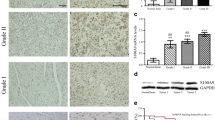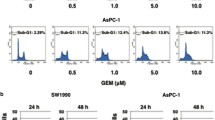Abstract
It has been shown that over-expression of Special AT-rich binding protein 1 (SATB1) in breast cancer predicts a poor prognosis. This study was aimed at investigating the effects of silencing SATB1 on mesenchymal derived human osteosarcoma U2OS cells and the underlying mechanisms. The expressions of SATB1 and the related genes in the cells were detected by qRT-PCR and/or Western Blotting. SATB1 silencing was achieved by stable transfection with the vectors expressing small hairpin RNA versus SATB1. Cell proliferation was detected in a microplate reader with Cell Counting Kit-8 and the cell cycle was analyzed by flow cytometry using a cell cycle detection kit. The study found that SATB1 was particularly over-expressed in human osteosarcoma U2OS. Silencing SATB1 inhibited the proliferation of U2OS. It was found that inhibition of cell proliferation resulted from cell cycle arrest due to down-regulated expression of CFGF and JunB. The over-expression of SATB1 is responsible for abnormal proliferation of mesenchymal derived human Osteosatcoma U2OS cells, indicating that silencing SATB1 expression in the cells might be developed as an efficient osteosarcoma therapy. CTGF and JunB were involved in SATB1-mediated proliferation of U2OS cells.





Similar content being viewed by others
References
Dickinson LA, Joh T, Kohwi Y, Kohwi-Shigematsu T (1992) A tissue-specific MAR/SAR DNA-binding protein with unusual binding site recognition. Cell 70:631–645
Tattermusch A, Brockdorff N (2011) A scaffold for X chromosome inactivation. Hum Genet 130:247–253
Yamaguchi H, Tateno M, Yamasaki K (2006) Solution structure and DNA-binding mode of the matrix attachment region-binding domain of the transcription factor SATB1 that regulates the T-cell maturation. J Biol Chem 281:5319–5327
Seo J, Lozano MM, Dudley JP (2005) Nuclear matrix binding regulates SATB1-mediated transcriptional repression. J Biol Chem 280:24600–24609
Shannon MF (2003) A nuclear address with influence. Nat Genet 34:4–6
Cai S, Han HJ, Kohwi-Shigematsu T (2003) Tissue-specific nuclear architecture and gene expression regulated by SATB1. Nat Genet 34:42–51
Han HJ, Russo J, Kohwi Y, Kohwi-Shigematsu T (2008) SATB1 reprogrammes gene expression to promote breast tumour growth and metastasis. Nature 452:187–193
Zheng J (2008) Is SATB1 a master regulator in breast cancer growth and metastasis? Womens Health (Lond Engl) 4:329–332
Li QQ, Chen ZQ, Xu JD, Cao XX, Chen Q, Liu XP, Xu ZD (2010) Overexpression and involvement of special AT-rich sequence binding protein 1 in multidrug resistance in human breast carcinoma cells. Cancer Sci 101:80–86
Cheng C, Lu X, Wang G, Zheng L, Shu X, Zhu S, Liu K, Wu K, Tong Q (2010) Expression of SATB1 and heparanase in gastric cancer and its relationship to clinicopathologic features. APMIS 118:855–863
Chen H, Takahara M, Oba J, Xie L, Chiba T, Takeuchi S, Tu Y, Nakahara T, Uchi H, Moroi Y, Furue M (2011) Clinicopathologic and prognostic significance of SATB1 in cutaneous malignant melanoma. J Dermatol Sci 64:39–44
Siclari VA, Qin L (2010) Targeting the osteosarcoma cancer stem cell. J Orthop Surg Res 5:78–87
Mohseny AB, Machado I, Cai Y, Schaefer KL, Serra M, Hogendoorn PC, Llombart-Bosch A, Cleton-Jansen AM (2011) Functional characterization of osteosarcoma cell lines provides representative models to study the human disease. Lab Invest 91:1195–1205
Raile K, Hoflich A, Kessler U, Yang Y, Pfuender M, Blum WF, Kolb H, Schwarz HP, Kiess W (1994) Human osteosarcoma (U-2 OS) cells express both insulin-like growth factor-I (IGF-I) receptors and insulin-like growth factor-II/mannose-6-phosphate (IGF-II/M6P) receptors and synthesize IGF-II: autocrine growth stimulation by IGF-II via the IGF-I receptor. J Cell Physiol 159:531–541
Heldin CH, Johnsson A, Wennergren S, Wernstedt C, Betsholtz C, Westermark B (1986) A human osteosarcoma cell line secretes a growth factor structurally related to a homodimer of PDGF A-chains. Nature 319:511–514
Wang Y, Wei Y, Zhang H, Shi Y, Li Y, Li R (2012) Arsenic trioxide induces apoptosis of p53 null osteosarcoma MG63 cells through the inhibition of catalase. Med Oncol 29:1328–1334
Meng WJ, Yan H, Zhou B, Zhang W, Kong XH, Wang R, Zhan L, Li Y, Zhou ZG, Sun XF (2011) Correlation of SATB1 overexpression with the progression of human rectal cancer. Int J Colorectal Dis 27:143–150
Tu W, Luo M, Wang Z, Yan W, Xia Y, Deng H, He J, Han P, Tian D (2012) Upregulation of SATB1 promotes tumor growth and metastasis in liver cancer. Liver Int 32(7):1064–1078
Bradham DM, Igarashi A, Potter RL, Grotendorst GR (1991) Connective tissue growth factor: a cysteine-rich mitogen secreted by human vascular endothelial cells is related to the SRC-induced immediate early gene product CEF-10. J Cell Biol 114:1285–1294
Maeda A, Nishida T, Aoyama E, Kubota S, Lyons KM, Kuboki T, Takigawa M (2009) CCN family 2/connective tissue growth factor modulates BMP signalling as a signal conductor, which action regulates the proliferation and differentiation of chondrocytes. J Biochem 145:207–216
Fujisawa T, Hattori T, Ono M, Uehara J, Kubota S, Kuboki T, Takigawa M (2008) CCN family 2/connective tissue growth factor (CCN2/CTGF) stimulates proliferation and differentiation of auricular chondrocytes. Osteoarthr Cartil 16:787–795
Hoshijima M, Hattori T, Inoue M, Araki D, Hanagata H, Miyauchi A, Takigawa M (2006) CT domain of CCN2/CTGF directly interacts with fibronectin and enhances cell adhesion of chondrocytes through integrin alpha5beta1. FEBS Lett 580:1376–1382
Jiang CG, Lv L, Liu FR, Wang ZN, Liu FN, Li YS, Wang CY, Zhang HY, Sun Z, Xu HM (2011) Downregulation of connective tissue growth factor inhibits the growth and invasion of gastric cancer cells and attenuates peritoneal dissemination. Mol Cancer 10:122
Shaulian E (2010) AP-1–The Jun proteins: oncogenes or tumor suppressors in disguise? Cell Signal 22:894–899
Piechaczyk M, Farras R (2008) Regulation and function of JunB in cell proliferation. Biochem Soc Trans 36:864–867
Shaulian E, Karin M (2002) AP-1 as a regulator of cell life and death. Nat Cell Biol 4:E131–E136
Johnson KJ, Hensley JB, Kelso MD, Wallace DG, Gaido KW (2007) Mapping gene expression changes in the fetal rat testis following acute dibutyl phthalate exposure defines a complex temporal cascade of responding cell types. Biol Reprod 77:978–989
Wang T, Hao L, Feng Y, Wang G, Qin D, Gu G (2011) Knockdown of MED19 by lentivirus-mediated shRNA in human osteosarcoma cells inhibits cell proliferation by inducing cell cycle arrest in the G0/G1 phase. Oncol Res 19:193–201
Acknowledgments
This study was supported in part by the Platform Fund for The Key Laboratory of Pathobiology, Ministry of Education, Jilin University (No. 450060481302) and Jilin University Initiation Fund (No. 450091105188) for “The Tang Aoqing Distinguished Professor.” We would like to express our great appreciation to Dr. Xuejin Su, for his excellent technical assistance and to Professor F. William Orr from the University of Manitoba in Canada for his great help in revising the manuscript.
Conflict of interest
The authors declare that they have no conflicting or competing interests.
Author information
Authors and Affiliations
Corresponding authors
Rights and permissions
About this article
Cite this article
Zhang, H., Qu, S., Li, S. et al. Silencing SATB1 inhibits proliferation of human osteosarcoma U2OS cells. Mol Cell Biochem 378, 39–45 (2013). https://doi.org/10.1007/s11010-013-1591-0
Received:
Accepted:
Published:
Issue Date:
DOI: https://doi.org/10.1007/s11010-013-1591-0




